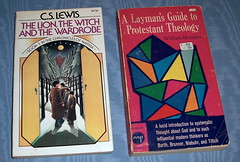
The Narnia flick was recently shown at the MSU Student Union, so I figured I'd write a short theological discourse ;-) (Yes, yes, the Narnia books were written for very young children and can't stand up to much analysis. But I can't help myself.)
In The Lion, the Witch, and the Wardrobe book, Aslan wakes up from a hundred-year catnap, finds Narnia in a deep-freeze, and calls the four Pevensie kids to help set things right. Edmund betrays his siblings to the White Witch, and thus becomes her "lawful prey." Edmund is saved from death when Aslan takes Edmund's place. After being slain by a quick thrust of a knife, Aslan dies. He comes back, however, because of a heretofore unknown rule (the Deeper Magic).
Aslan's death and resurrection parallel the "classical theory" of atonement that held sway over Christian thinking until about A.D. 1000. According to this theory, humanity was enslaved to Satan as a consequence of sin. Satan thought he was making quite the bargain with God when God offered up his Son to be sacrificed in humanity's place. In a cosmic version of Calvinball, Satan was unaware of the game's actual rules, and lost everything.
Did Aslan sacrifice himself to save all of Narnia, or just Edmund? All of Narnia, since Narnia was only going to be saved if the four Pevensie kids occupied to the four thrones.
So there you go - an analysis by a non-religious resident of Montana. I can think of several Montana bloggers who could offer other perspectives: Zen, Objectivist, Catholic, Franciscan, Jewish, Pagan...
---
Technorati tags: narnia, aslan, atonement

No comments:
Post a Comment